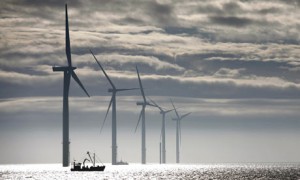So as the Obama administration delays a Bush faux-solution to expand torture drilling, the Interior department is focused on developing offshore wind power. Coincidental to this, researchers report that one “unexpected quirk” of climate change is that wind speed is picking up off the coast of England.
Based on information taken from Nasa satellite images, the research found that average annual wind speed in the southern part of the North Sea had increased from about 7.5 metres per second in 1990 to 8.5 metres in 2008. In contrast, wind speeds in the northern part of the North Sea, off the coast of Scotland, have remained constant during this period.
If these trends continue, in a decade the south could be windier all year round than northern areas and double the power generated by wind farms off the coast of East Anglia and Essex.
For those poised to make a buck, why not jump in where you can make three? Apparently the sites off the Nantucket Sound are attractive not only because of significant sustained winds, but the shallow waters keep installation costs down. A major cost of installing the turbines is the offshore foundations themselves, such that the British government just launched a £20 million competition to accelerate a 30% cut in costs for deep water foundations. But, wait – we just read that
Until now, developers have relied on wind-speed levels taken on oil and gas installations or have used meteorological masts planted offshore. The Met Office has only limited satellite data to track offshore wind speeds in the North Sea but is working with wind-farm developers to produce a comprehensive set of data of the last 30 years. A spokeswoman admitted it would take two years to develop.
Duncan Ayling, head of offshore renewables at the British Wind Energy Association, said: “There have been wind-speed measurements on oil and gas installations that give some localised historic data, but a lot of the rest of it is extrapolation. If this technology provides an accurate measurement, it would be very exciting. More wind equals more money for projects. It would enable wind-farm developers to more accurately forecast revenues and have more certainty about the expected return on their investment.”
Emphasis mine. Oil and gas installations that are… already out there in the windy North Sea, in the Gulf of Mexico, off the coast of California and elsewhere. Many of these are abandoned or likely to be tapped out soon. What happens to them when the spigot from down below runs dry? Can’t they be topped with a wind turbine, gigantic and lovely? Doesn’t fix everything or end the discussion, though we stipulate that neither of these is the point; also, far superior to highly-stylized schools of thought centered around 1) doing the same things and expecting different results and 2) Let’s Do Nothing!
Plus reuse is PR gold so this fulfills the implicit double entendre requirement for what green means. Please make checks payable to the editor.

